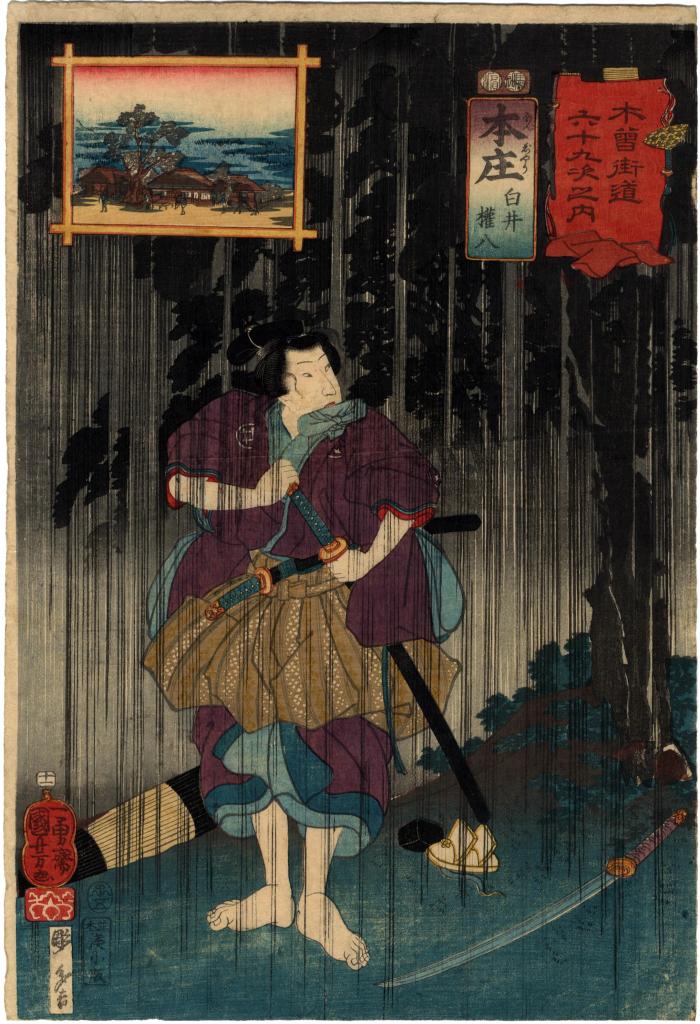Utagawa Kuniyoshi (歌川国芳) (artist 11/15/1797 – 03/05/1861)
Honjō (本庄): Shirai Gonpachi (白井權八) from the series Sixty-nine Stations of the Kisokaidō Road (Kisokaidō rokujūkyū tsugi no uchi - 木曾街道六十九次之内)
05/1852
10.125 in x 14.75 in (Overall dimensions) Japanese woodblock print
Signed: Ichiyūsai Kuniyoshi ga
一勇斎国芳画
Artist's seal: kiri
Publisher: Minatoya Kohei
(Marks 332 - seal 24-075)
Carver: Hori Takichi
Censor seals: Hama and Magome
Date: 5/1852
Number 11: 十一
Museum of Fine Arts, Boston
British Museum
Waseda University
Tokyo Metropolitan Library
Hiroshige Museum of Art
Musée Cernuschi
Van Gogh Museum "In real life, the samurai-turned-highwayman Hirai Gonpachi was executed in 1679, and his lover, the courtesan Komurasaki, committed suicide on his grave. Their tragic love story was celebrated in popular songs and later in plays, with Gonpachi's family name prudently changed from Hirai to Shirai to avoid trouble with the censors. Shirai means literally 'white well,' the symbol used as Gonpachi's personal crest and visible here on the shoulders of his kimono. The tic-tac-toe shape of a traditional Japanese well also forms a frame for the inset landscape...
The scene illustrated by Kuniyoshi is from the beginning of the kabuki play The Floating World's Pattern and Matching Lightning Bolts (Ukiyo-zuka hiyoku no inazuma), which premiered in 1823. In both real life and drama, Gonpachi's criminal career began in his home province of Tottori, where he killed a man name Honjō Sukedayū, whose surname is the same as the name of Honjō station. The print shows the moment just after the killing, when Gonpachi emerges from Honjō's house into the rain. An umbrella and a rain clog (with a cover to keep the foot dry) can be seen on the ground beside him; the umbrella and swords also appear in the series title border.
Gonpachi fled to Edo where, according to the kabuki version of his life, he met the chivalrous townsman Banzuin (Banzui) Chōbei, another character based on an actual historical personage (but one who died in 1657 and so could not have known Gonpachi in real life). The phrase 'matching lightning bolts' in the title of the play refers to the close friendship between the two brave men. In Edo, Gonpachi fell in love with Komurasaki of the Miuraya... who would join him in death. In some versions of the story, handsome young Gonpachi is bisexual and is romantically involved with both Chōbei and Komurasaki."
Quoted from: Utagawa Kuniyoshi: The Sixty-nine Stations of the Kisokaidō by Sarah E. Thompson, p. 38.
[Ukiyo-zuka hiyoku no inazuma is 浮世柄比翼稲妻.]
****
Listed, but unillustrated, in Japanese Woodblock Prints: A Catalogue of the Mary A. Ainsworth Collection, by Roger Keyes, p. 190, #498.
****
illustrated:
1) in black and white in the Catalogue of the Van Gogh Museum's Collection of Japanese Prints by Charlotte van Rappard-Boon, Willem van Gulik and Keiko van Bremen-Ito, 1991, p. 251, #358.
2) in a full-page color reproduction in Utagawa Kuniyoshi: the Sixty-nine Stations of the Kisokaidō by Sarah E. Thompson, Pomegranate Communications, Inc., 2009, page 39, no. 11.
landscape prints (fūkeiga 風景画) (genre)
mitate-e (見立て絵) (genre)
Minatoya Kohei (湊屋小兵衛) (publisher)
Shirai Gonpachi (白井権八) (role)
